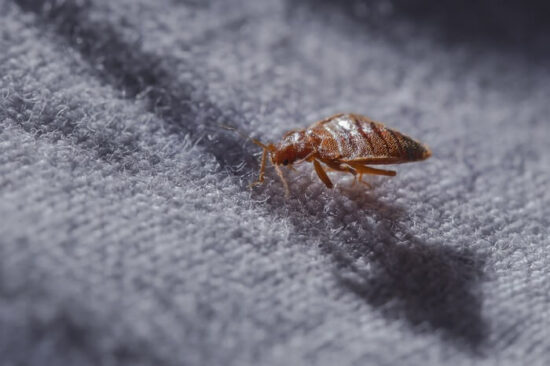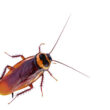Learning how to get rid of bed bugs in your carpet isn’t complicated, but it does require a fundamental understanding of how these insects spread. You see, getting these insects out of your carpet is a bit different than removing them from your bed!
This guide will teach you everything you need to know about bed bugs hiding out in carpets, and what your treatment options are.
Table of contents
Can Bed Bugs Live In Carpet?
While it’s usually not their first choice, bed bugs can and will live in your carpet.
Bed bugs are a parasitic insect that prefers to feed on human blood in the dead of night. Primarily nocturnal, they have a knack for staying hidden and emerging when you’re asleep and defenseless.
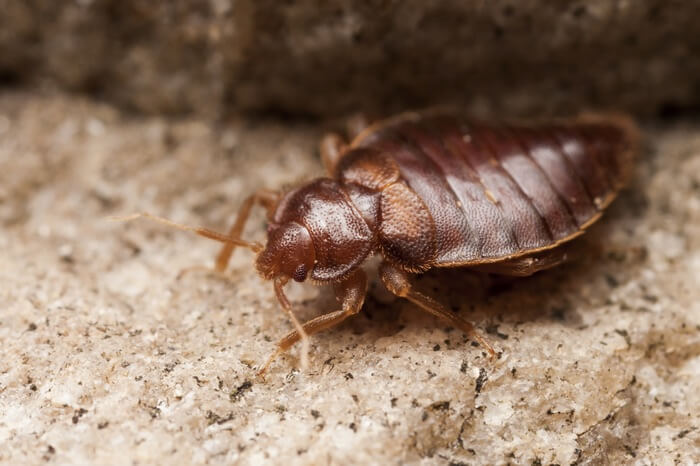
These insects get their common name from their habit of living in mattresses and box springs. Bedroom furniture is the go-to, but not for the reasons many think. In most cases, they live around beds because it allows them to stay close to their food source!
- Kill bed bugs and bed bug eggs
- Use spray as a spot treatment around bed frames, mattress seams/tufts/folds, and baseboards
- Kills even the toughest bed bugs
- The continuous spray Comfort Wand easily gets into hard-to-reach areas
However, they can technically live anywhere that’s conducive to their feeding habits. That includes cracks in the walls, small voids in your furniture, and anywhere else that keeps them hidden. As long as the spot is dark, discreet, and well-protected, they’ll move in.
Carpets fit that criteria to a tee!
All that said, carpet isn’t the most ideal place for bed bugs to live. Just because they can reside there doesn’t mean that they will. Unless you sleep on the floor every night, these pests will likely look elsewhere for shelter.
You see, bed bugs aren’t the most robust crawlers in the insect kingdom. They make their way around most surfaces just fine, but the thick jungle of fibers in a carpet often slows them down.
Quick Tip: If you spot some of these bloodsuckers on your plush carpet, there’s a good chance that you caught them in transit to another location. Or, it could be a sign of a severe infestation.
How They Get There
Bed bugs can end up in your carpet for many different reasons.
The most common is that they’re simply moving to another nesting spot. Cursed with an insatiable hunger, bed bugs are always looking to eat.
They must feed regularly to continue developing. Baby bed bugs have to eat to shed their skin and move through the various growth stages before becoming an adult. While they do take some time off to digest their food between meals, it’s only a matter of days before they’re on the hunt again!
Bed bugs move to other locations pretty regularly. Whether it’s because they want to find a new source of food or because their old spot was compromised, it’s not uncommon to see these pests en route to “greener pastures.”
Sometimes, bed bugs end up in your carpet accidentally. For example, say that you move your mattress by dragging it across the floor. A small number of bed bugs are bound to fall off and hurry into the carpet fibers.
The act of inadvertently spreading bed bugs is easier than most think. Just toss around an infested pillow or pile of clothes, and you’ll end up with tons of creepy crawlies on your carpet.
Quick Tip: As if that weren’t bad enough, it doesn’t take much for those bugs to multiply. Adult female bed bugs can lay up to five eggs a day, spreading fast in a matter of days.
The last reason bed bugs are in your carpet is because of a lack of room elsewhere.
When normal nesting spots reach capacity, bed bugs have no choice but to move to another location. Remember, these bugs lay several eggs every day! Overpopulation is a real issue that forces pests out of hiding and into the light.
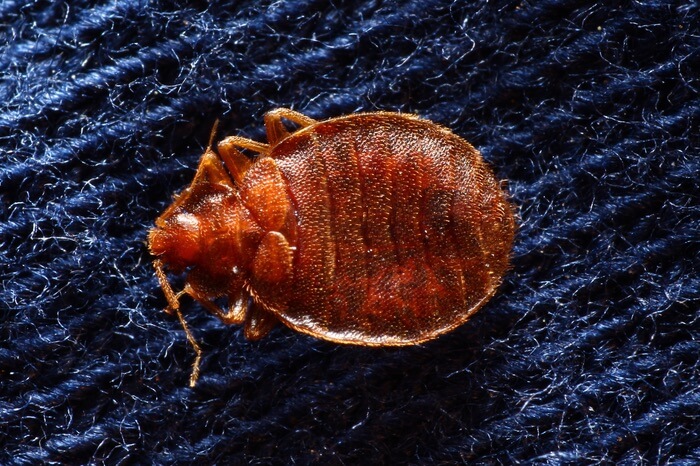
If you see bed bugs on the carpet regularly, you may only scratch the surface of a much broader problem in your home.
Signs That You Have Bed Bugs In Your Carpet
Want to know the most obvious sign that you have bed bugs in your carpet? It’s seeing live bugs crawling on your carpet!
Pay close attention to the corners of the room and around baseboards. Bed bugs are most likely to congregate in these areas.
Quick Tip: If you spot a single bug, keep looking for more. Bed bugs secrete pheromone scents that they use to signal other bugs. It’s a way of marking a “safe” space. Finding one bug could mean that more are nearby.
In addition to finding live bed bugs in your carpet, you might also see remnants of their presence. Bed bugs are filthy through and through! They leave behind feces, shed exoskeletons, and spots of blood.
The feces appear as tiny black dots. They can be challenging to see in some situations. But if you have a light-colored carpet, you may notice smears.
The same goes for blood spots. Bed bugs need several days to digest the blood they eat. Sometimes, they throw up some of it. Like feces, you’re more likely to see those spots on light-colored floors.
- Kill bed bugs and bed bug eggs
- Use spray as a spot treatment around bed frames, mattress seams/tufts/folds, and baseboards
- Kills even the toughest bed bugs
- The continuous spray Comfort Wand easily gets into hard-to-reach areas
Tiny exoskeletons are a byproduct of the nymph growth cycle. Adult bed bugs don’t shed, but the juveniles will get rid of their old skin about five times. Keep an eye out for those molts, as they can sometimes leave a trail of the bug’s activity.
How To Kill & Get Bed Bugs Out Of Carpet
Getting rid of bed bugs in your carpet can be notoriously difficult. When things have gotten to the point where they’ve invaded such an expansive surface, it presents a lot of challenges!
Fortunately, killing bed bugs in your carpet is doable if you follow the steps below.
1. Empty The Room
Before you do anything, you need to clear the room of furniture.
Not only that, but you need to treat those items to ensure that they’re not holding any bed bugs. Your efforts to get the bed bugs out of your carpet will be fruitless if you ignore the other objects in the area. That includes the ones on your clothes, furniture, and everything else.
Plus, failing to treat all of these objects could make these bugs spread even more.
Inspect all furniture and apply a material-safe insecticide spray. Pay close attention to cracks and voids. It’s a good idea to clean and vacuum all upholstery as well.
Quick Tip: For soft fabrics and washable materials, toss everything in the washing machine! Bed bugs can’t stand the heat. Put your appliance on the highest setting, and all the bugs should die by the end of the cycle.
Now, onto the more difficult-to-clean items. Anything you can’t spray or wash should go into a sealable plastic bag. You can treat those items separately later. Alternatively, you can put them in storage for a year or so.
A sealed plastic bag isn’t going to do anything to kill the bugs on its own (bed bugs can live in plastic bags for quite a while). However, it will help prevent their spread. Keep them in there long enough, and you can eventually starve the bugs to death.
However, keep in mind that this can take up to 400 days. Bed bugs can live for a very long time without food, so you’ll have to be patient if you choose to rely on that method!
Take this opportunity to do some cleaning. Remove every last item and toss anything that you don’t mind losing.
Bed bugs can quickly reinfest any item you introduce back into the room, so treat everything you can to avoid a spread. When homeowners learn how to get rid of bed bugs in their carpet, this is one of the steps that many overlook.
Once your room is empty and you have access to the entire carpet surface area, you’re ready to move onto the next step.
2. Vacuum
Believe it or not, your vacuum cleaner can do a lot when it comes to getting rid of bed bugs in your carpet!
Your vacuum will suck them right out of the carpet. It won’t kill the pests, but it will displace them and prevent spread.
Now, the type of vacuum you use matters here. Cheap machines with weak seals may do more harm than good. The last thing you want is for the bed bugs to spread from the carpet to other parts of the house.
Use a bagged vacuum that provides as minimal contact with the dirt and bugs as possible. If you have access to one, use a device with a HEPA filter.
HEPA filters prevent dirt from becoming airborne. They have robust seals that are perfect for keeping bed bugs contained.
Do several passes over your carpet to get the bed bugs out. Take advantage of any available attachments to get into hard-to-reach corners and edges, too. Just make sure that the attachments are connected to the sealed bag all the same.
Quick Tip: Once you vacuum thoroughly, dispose of the vacuum bag immediately. Place it in another sealable plastic bag for good measure. Then, toss it into the garbage can outside!
3. Spread Some Bed Bug Carpet Powder
Carpet powder is a great way to kill any leftover bed bugs that make it through the initial vacuuming phase. Many insecticide manufacturers have powder products that work to dehydrate and slowly kill pests.
Alternatively, you can use diatomaceous earth. Diatomaceous earth is an all-natural product that’s made out of the fossilized remains of algae called diatoms. When crushed up, the silica-like powder is incredibly sharp and abrasive to pests.
Nevertheless, it’s safe enough for humans to handle!
On contact, the powder causes tons of microscopic injuries. It makes bed bugs bleed out, dehydrate, and die!
Sprinkle some of the powder onto your carpet, and make sure to get into all the fibers. Let the powder sit for several minutes before following up with another round of vacuuming.
Quick Tip: To be safe, make sure you wear some protective gear. While diatomaceous earth is relatively safe to handle, it can still cause harm if you inhale it. Wear a mask and open some windows to ventilate the room. Also, keep all pets and children out of the area while you’re using it.
4. Use A Steam Cleaner
Earlier, we mentioned that bed bugs don’t handle heat well.
You can use that fact to your advantage when killing bed bugs in your carpet! Steam cleaners deliver a blast of vaporized water into your carpets. Most machines can push the steam deep into the fibers and pad.
When using a steam cleaner, try to get a device that reaches temperatures of at least 118 degrees Fahrenheit. If you can go even higher, go for it!
Bed bugs start to die off at 118 degrees Fahrenheit. However, it takes continual exposure to ensure death. Because steam cleaners work like vacuum cleaners, bugs will only have a few moments of exposure to the steam.
There are no guarantees with this technique, so it’s best to use it after you’ve gone through all of the previous tips. Think of it more as an extra security measure than anything else.
5. Try A Heat Treatment
Last but not least, you can use heat treatment to get rid of bed bugs in your carpet. This step is only necessary if the insects are resilient enough to survive all previous efforts.
Heat treatments are different from standard steam cleaners. First, they’re only available from professionals.
Steam cleaning is an arduous process that requires a professional’s experience to do effectively. It involves raising the temperatures of the entire room. The exact temperature varies from case to case, but most exterminators will go well above the fatal range for bed bugs.
This technique involves a lot of preparation (and some expense), but the payoff is well worth it.
Preventing Them From Getting Into Your Carpet In The Future
Preventing bed bug infestation is an ongoing process. After you get rid of all of the bed bugs in your carpet, there’s always a chance that they can come back.
Bed bugs are more common than people think. They’re everywhere! Because of this, you have to be proactive to ensure that you never have to deal with this nightmare ever again!
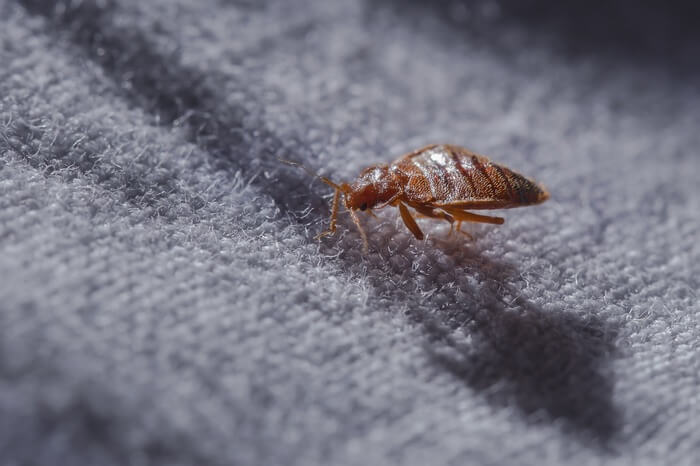
When adding new furniture and accessories to your room, inspect everything. This is especially important when buying second-hand pieces. However, bed bugs can appear on new showroom items, too.
Look around every nook and cranny to ensure that no bed bugs are waiting to hitchhike their way into your home!
For existing furniture and the room itself, you’ll need to take some preventative measures. Look for any cracks and voids, then seal them up with caulk.
Quick Tip: Bed bugs gravitate to discrete spots that offer protection and security. Small gaps and cracks in furniture, baseboards, and walls are the go-to. Sealing those areas up will make it difficult for any future bugs to find safety.
Finally, don’t forget to vacuum and clean regularly.
Adopt a strict cleaning schedule and stick to it! Vacuuming your carpet will pick up any stray bugs and eggs that make their way into your room. This helps you prevent populations from spreading and flourishing.
We recommend cleaning at least once a week for the best results.
Can Bed Bugs Live Under Carpets?
We already know that bed bugs can live in carpets. But what about underneath them?
Carpets sit on top of a layer of padding and your subfloor. Some also have underlayment.
Those various layers are great for keeping bed bugs safe. If they have access, bed bugs will absolutely move underneath your carpet!
They usually get there through holes in the carpet padding. Rough corners and exposed edges can serve as access points, too.
The size of bed bugs is quite small, meaning these insects don’t need much room to squeeze their way through tough spots. The pests can fit through any space that’s thin enough to slide a credit card through.
If you suspect bed bugs are living under your carpet, you may need to rip the flooring up to treat the problem. Exterminators might be able to use heat treatments to penetrate through the carpet. However, it all depends on the severity of the issue and the quality of your carpet.
To prevent issues like that from occurring, make sure that your carpet is sealed and adequately attached to the subfloor.
Can Bed Bugs Live Inside A Carpet Cleaner?
Let’s address a common worry that homeowners have about renting carpet cleaners.
Rentable appliances have a lot to offer when it comes to killing and getting bed bugs out of your carpet. You can get all the cleaning and bug-killing power you need without the high costs of ownership, but can you actually spread bed bugs when you’re using them?
Bed bugs are excellent hitchhikers. Most infestation cases actually occur when people encounter them at hotels or other public places.
Whether or not they can travel in carpet cleaners depends on the quality of the machine.
Standard carpet washers don’t have much that’s going to kill these pests. So, it’s definitely possible that they could survive, stow away in the machine, and spread onto the next person who’s unfortunate enough to use it.
On the other hand, steam cleaners are a bit different. Steamers have integrated heating elements that bring the temperature of the water up enough to produce powerful steam. Bed bugs are unlikely to survive in those conditions, as they die with continued exposure to heat.
Quick Tip: That said, they may survive on other parts of the machine. Bed bugs can, theoretically, crawl into the casing or hide on the exterior features of the device. There, they can lay eggs and spread while steering clear of the dangerous parts of the steamer.
Overall, getting bed bugs from a carpet cleaner is unlikely. However, it’s still possible.
If you want to be on the safe side, it’s much better to buy than rent. Buying might cost more, but you’ll get peace of mind and unlimited use of a powerful bug-killing machine.
Final Thoughts
Now that you know how to kill bed bugs in your carpet, there’s nothing stopping you from chipping away at your infestation. It will take a little bit of effort, but it’s completely doable if you follow our instructions above.
If you have any questions about the treatment methods above, send them our way.
